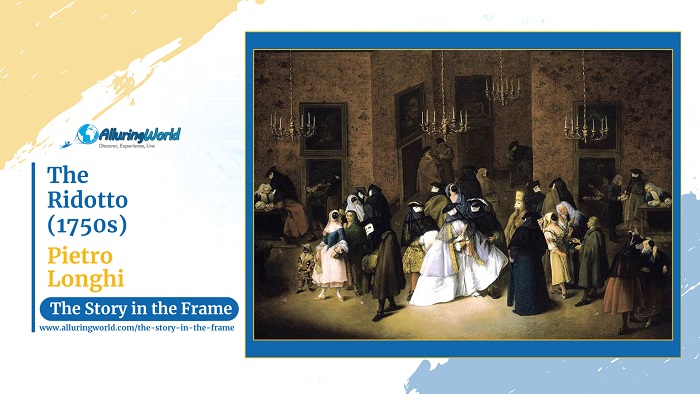The Ridotto is a captivating painting that gives a glimpse into the social life of Venetian high society that was painted by Pietro Longhi in the mid-18th century, possibly in the 1750s. The work captures the lively and mysterious atmosphere of the ridotto which was a public gambling house in Venice that also served as a place for masked encounters, secret exchanges, and flirtatious interactions. Longhi’s painting provides a valuable visual record of the customs, fashion, and entertainment of the Venetian aristocracy during the Rococo period, and his keen eye for detail and subtle humor make this piece a charming yet insightful commentary on society’s pleasures and intrigues.
About the Painter:
Pietro Longhi (1701–1785) was a Venetian painter best known for his intimate and detailed depictions of 18th-century Venetian life. Unlike the grand historical painters of his time, Longhi focused on domestic interiors, masked balls, and the everyday activities of the Venetian elite, much like a visual chronicler of his society. His works are often filled with subtle satire, emphasizing the manners and eccentricities of his subjects, and through his paintings, Longhi offers a rare and entertaining look into the private world of Venice, balancing elegance with a gentle critique of aristocratic pastimes.
Inspiration and Reasons Behind the Painting:
The Ridotto was inspired by Venice’s unique cultural environment, where gambling, social intrigue, and masked identities played a major role in everyday life, so the ridotti were officially sanctioned gambling houses attached to the famous Carnival of Venice, where nobles, courtesans, and commoners, often disguised behind masks, mingled freely. Longhi sought to capture the allure and theatricality of these settings, portraying them as places of both amusement and deception, and his work subtly comments on the duplicity of Venetian society, where appearances were everything, and social boundaries were blurred under the anonymity of the mask.
What is Depicted in the Painting:
The painting shows a group of elegantly dressed figures gathered inside the ridotto, and as they are all engaged in conversation, observation, and perhaps mild flirtation, there are numerous individuals who are disguising themselves by wearing the traditional Venetian bauta mask and black cloak, symbols of secrecy and social freedom. Others are dressed in elaborate Rococo fashion with their powdered wigs and luxurious fabrics reflecting their aristocratic status, and there is a seated nobleman who appears to be conversing with a masked woman to the central-right section of the painting, while others glance around the room, absorbed in the social spectacle. The setting is dimly lit, with chandeliers providing a warm glow that enhances the sense of intimacy and intrigue.
Colors and Techniques:
Longhi’s color palette is soft and muted, dominated by warm earth tones, gentle pastels, and rich golden hues that evoke the elegant interiors of Venice’s grand halls. His brushwork is delicate and precise, focusing on the intricate details of clothing, facial expressions, and interactions between the figures. Unlike the dramatic contrasts of Baroque painting, Longhi’s technique is subtle, emphasizing refinement over grandeur, and as he employs a balanced composition, drawing the viewer’s eye across the scene, he is also ensuring that each character contributes to the overall narrative of the painting.
Conclusion:
Overall, The Ridotto is more than just a depiction of 18th-century Venetian entertainment since it is a window into the rituals, excesses, and social dynamics of a city at the height of its cultural influence. Longhi’s ability to blend realism with gentle satire makes this work a lasting testament to Venice’s fascination with spectacle and disguise, and even today, it remains a valuable piece for understanding both the allure and the contradictions of Venetian society, where behind every mask lay a story waiting to be told.

